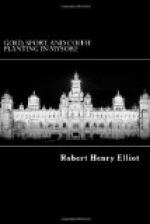The quantity of manure that should be annually supplied is evidently a matter of the greatest importance, and here the first thing to be borne in mind is that of the four manures we require, namely, lime, nitrogen, phosphoric acid, and potash, the first two are somewhat easily removed from the soil, while the last two are firmly retained by it. It is evident, then, that lime and nitrogen should be applied little and often, while phosphoric acid and potash may be applied either little and often, or in large quantities at longer intervals, whichever may be found most convenient. But in the opinion of an eminent agricultural chemist whom I have specially consulted on the subject, nitrogen, if applied in slowly decomposing form, as for instance, in the shape of oil-cake, would only be lost in an infinitesimal degree, but still he admits that there would be a loss, and as we cannot tell what that loss may amount to under the influence of our tropical climate and deluges of rain, it would be safe to assume that nitrogen, as well as lime, should be put down at short intervals and, in order to make up for the escape of these manures from the soil, in larger proportions than either phosphoric acid or potash.
I have pointed out that phosphoric acid is retained by the soil, and it is important to remember that it is only removed by the crops of coffee to the extent of from one-and-a-half to two pounds per acre per annum, and these are two facts that every planter should bear in mind when he contemplates following the common custom of manuring with bones. For if he remembers that about one-half of the bones consists of phosphate of lime, and that about one-half of the latter consists of phosphoric acid, he will at a glance see, when he estimates the amount of phosphoric acid removed by the crops, that if he puts down even 100 lbs. of bones per acre he will have put down enough phosphoric acid for about twelve crops of coffee. And yet for a planter to put down 3 cwt. of bones per annum regularly is quite a common thing, and a friend of mine, after having manured his land one year with bones to a moderate amount, put down each year, for the two following years, no less than three-quarters of a ton of bone-meal per acre. So that, making a large allowance for the phosphoric acid taken up




